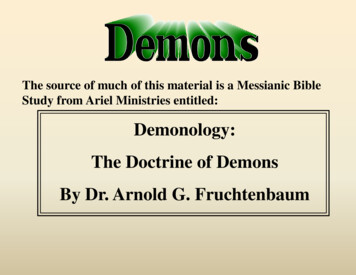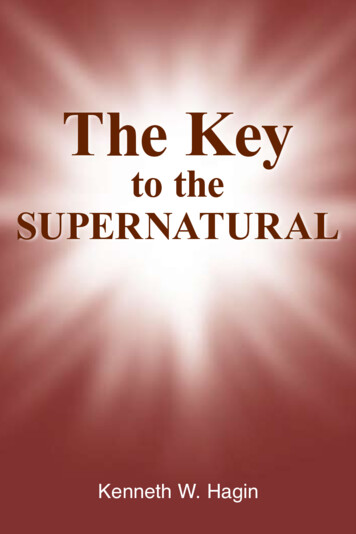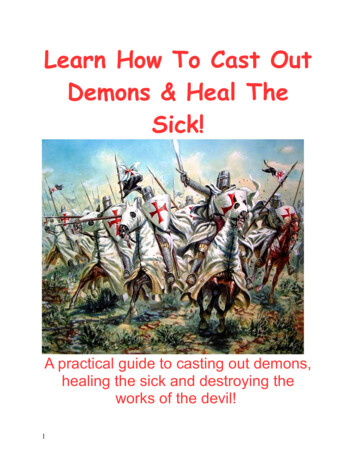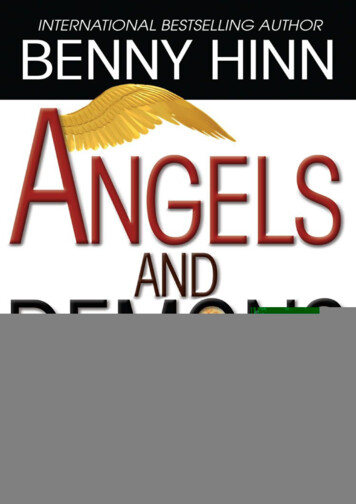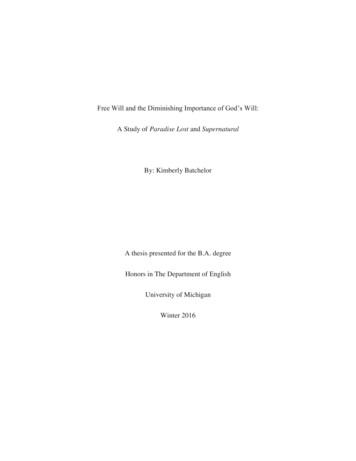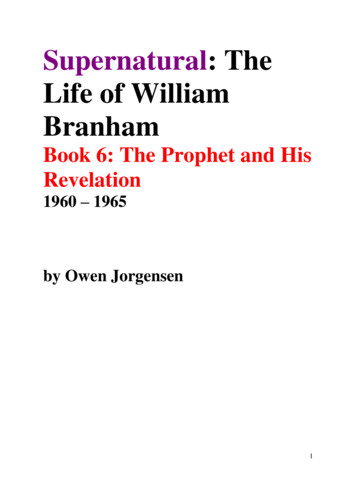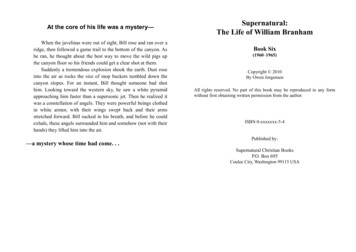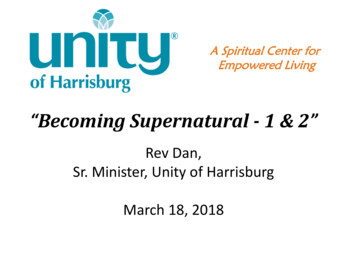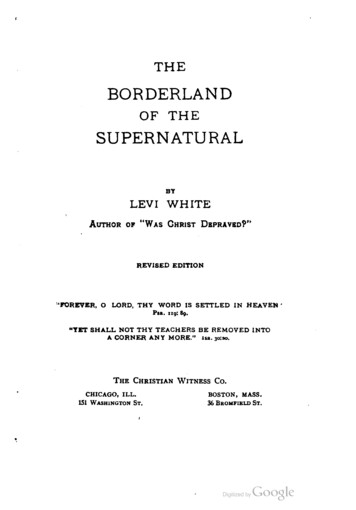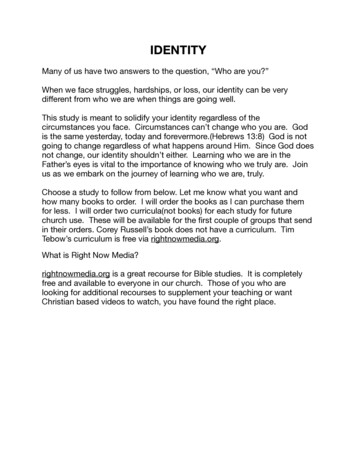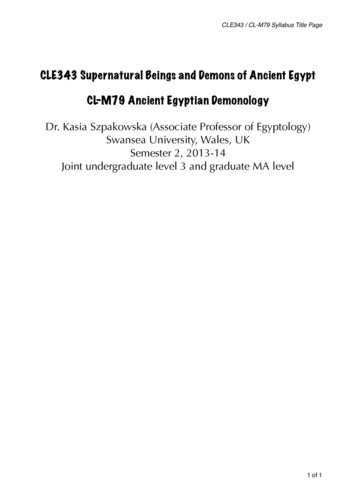
Transcription
CLE343 / CL-M79 Syllabus Title PageCLE343 Supernatural Beings and Demons of Ancient EgyptCL-M79 Ancient Egyptian DemonologyDr. Kasia Szpakowska (Associate Professor of Egyptology)Swansea University, Wales, UKSemester 2, 2013-14Joint undergraduate level 3 and graduate MA level1 of 1
SUPERNATURAL BEINGS AND DEMONS OF ANCIENT EGYPT(CLE343/CL-M79)IntroductionAncient Egyptian textual and non-textual evidence bespeaks a wide-spread belief in anindeterminate range of demonic beings that influenced the world of the living and ofthe dead. This module explores the nature of these liminal entities—both hostile andbeneficial—that filled the zones between human, animal, and god, and the methodsused by religious scholars to study them. The sources will include texts (such as CoffinTexts, literary texts, spells), representations (on artifacts and tomb walls), and objects(such as ivory wands and apotropaic figurines). The Egypt Centre provides anopportunity to engage with the evidence directly. We will also have a field trip toanother collection.Dr. Kasia SzpakowskaJames Callaghan 11901792 (51)3104K.Szpakowska@swansea.ac.ukClass Times:Wed, 11-1, KH216DynamicsThis is a seminar module, not lecture, so a good class depends on you. The first classwhich will be an introductory lecture on supernatural beings and the study of them,along with examples of how to use the evidence. As seminars can be deadly without alively dialogue, it is important that each of you express opinions, as well as question,challenge, and engage your colleagues. Every week you will pick a supernatural beingor type to explore, and use a different dataset relating it to the theme of the week andthe case-study. For class, bring your notes so you can report and discuss your findings.Some of the classes will feature guest speakers (stay tuned!).** Books **Required Bibliography (you should purchase) Raven, Maarten J. (2012). Egyptian Magic: The Quest for Thoth's Book of Secrets. Cairo:American University of Cairo. (Note: While I have assigned readings for this, it iseven more useful if you read the whole thing as soon as possible.) Borghouts, Joris F. (1978). Ancient Egyptian Magical Texts. (Vol. 9). Leiden: E.J. Brill. Ritner, Robert K. (1993). The Mechanics of Ancient Egyptian Magical Practice. Chicago:The Oriental Institute of the University of Chicago. /saoc54.html] Readings will be available on Blackboard & in the library as well
CLE343/CL-M79 - Supernatural Beings and Demons of Ancient Egypt (updated Jan 28, 2014)2 of 9Highly Recommended to Read Archiv für Religionsgeschichte, 14, is dedicated to the topic of Ancient Demonology(including Ancient Egypt, Mesopotamia, Classical Greece and Rome). Hornung, E. (1996), Conceptions of God in ancient Egypt: The one and the many (Ithaca,New York: Cornell University Press). [B141 HOR] Kousoulis, Panagiotis I. M. (Ed.). (2011). Ancient Egyptian Demonology: Studies on theBoundaries between the Demonic and the Divine in Egyptian Magic. Leuven:Peeters.Pinch,G.(1994), Magic in Ancient Egypt (London: British Museum Press). [BF1591 PIN] Stein, R. L. and Stein, P. L. (2007), The Anthropology of Religion, Magic, and Witchcraft(2nd edn.; Boston: Allyn & Bacon). Van der Toorn, Karel, Becking, Bob, & van der Horst, Pieter W. (Eds.). (1999).Dictionary of Deities and Demons in the Bible (Second extensively revised editioned.). Leiden: Brill.Furtherbibliography for the sources you will be using in the module is on Blackboard An extensive bibliography is on http://www.demonthings.com/bibliography/** Syllabus **IMPORTANT: Readings are below. Bring all your readings and notes with you to class.This could be done via printout, notes (handwritten or on your computer) or online onyour computer/tablet/etc. You have to be able to refer to these texts throughout the class.All readings for lectures should have been read beforehand (including the one forsession 1) so that you will be able to participate. Also check the weekly folders onBlackboard for the tasks .
CLE343/CL-M79 - Supernatural Beings and Demons of Ancient Egypt (updated Jan 28, 2014)Week1TopicCaseStudy3 of 9ExerciseWhat’s a Demon & wheredo we find them?2Exploring theEvidenceDefinitions & Terms forBeings3Names & CombinationsSehaqeqmagical texts4Depiction & ManifestationBes-image orTaweret-imageworking withimages (wands)5CharacteristicsGatekeepers of theAfterlifeCoffin Texts6Demonic-HumanEnemies & AfflictionMongerersMagical & medicaltextsBook of the Deadinteractions IIGatekeepers of theAfterlife8ClassificationweretsOracular AmuleticDecrees9Divine-DemonicDivine Guardians inboth worldsRoyal Books of theAfterlife10Ancient Near East & MedSamanu Demoninteractions I7Demonic-HumanInteractionsField Trip 1British MuseumBasement TourField Trip 2Egypt CentreDemon TrailWorkshopAncient EgyptianDemonology ProjectDatabase** Readings (check folders on Blackboard) **Week 1 Introduction; Definitions; Sources & Evidence; Methodologies & ApproachesRaven 2012: Chapters 1 & 2Week 2 Definitions & Exploring the Evidence
CLE343/CL-M79 - Supernatural Beings and Demons of Ancient Egypt (updated Jan 28, 2014)4 of 9Kousoulis, Panagiotis I. M. (2011). The Demonic Lore of Ancient Egypt:Questions on Definition. In P. I. M. Kousoulis (Ed.), Ancient EgyptianDemonology: Studies on the Boundaries between the Demonic and the Divinein Egyptian Magic (pp. ix-xxi). Leuven: Peeters.Lucarelli, Rita. (2010). Demons (benevolent and malevolent). UCLAEncyclopedia of Egyptology. Retrieved from , Kasia. (2009). Demons in Ancient Egypt. Religion Compass,3(5), 799-805. doi: 10.1111/j.1749-8171.2009.00169.xHornung 1996: Chapter 2 Exploring the EvidenceWeek 3 Names & Combinations; textual descriptionsRaven 2012: Chapter 3Borghouts, Joris F. (1999). Lexicographical Aspects of Magical Texts. In S.Grunert & I. Hafemann (Eds.), Textcorpus und Wörterbuch: Aspekte zurägyptischen Lexikographie (Vol. 14, pp. 149-177). Leiden, Boston, Köln:E.J. Brill.Hornung 1996: Chapter 3Azzam, Lila M. (2009). The Demon shAqq. In el-Sharkawy & B. Samir(Eds.), The Horizon Studies in Egyptology in Honour of M. A. Nur el-Din(10-12 April 2007) (pp. 105-108). Cairo: Supreme Council of AntiquitiesPress. Individual gods (Sehaqeq) & working with magical spellsWeek 4 Depiction & Manifestation; structural approachesRaven 2012: Chapter 4 Practice of MagicSimandiraki-Grimshaw, Anna. (2010). Minoan Animal-Human Hybridity.In D. B. Counts & B. Arnold (Eds.), The Master of Animals in Old WorldIconography (pp. 93-106). Budapest: Archaeolingua Foundation.Fischer, Henry G. (1987). The Ancient Egyptian Attitude Towards theMonstrous. In A. E. Farkas, P. O. Harper & E. B. Harrison (Eds.), Monstersand Demons in the Ancient and Medieval Worlds: Papers Presented in Honorof Edith Porada (pp. 13-26). Mainz: Philipp von Zabern.Hornung 1996: Chapter 4Romano, James F. (1998). Notes on the Historiography and History ofthe Bes-Image in Ancient Egypt. Bulletin of the Australian Center forEgyptology, 9, 89-105.Weingarten, Judith. (1991). The Transformation of Egyptian Taweret intothe Minoan Genius: A study in cultural transmission in the Middle Bronze Age.Partille: Paul Astroms. Manifestations of Bes- or Ipet-image & images (wands)Week 5 Characteristics; functional approaches; limits of power; locomotion; emotionsGUEST LECTURERaven 2012: Chapter 5 Books of MagicLucarelli, Rita. (2012). The so-called vignette of Spell 182 of the Book ofthe Dead. In R. Lucarelli, M. Müller Roth & A. Wütrich (Eds.),
CLE343/CL-M79 - Supernatural Beings and Demons of Ancient Egypt (updated Jan 28, 2014)5 of 9Herausgehen am Tage. Gesammelte Schriften zum altägyptischen Totenbuch(pp. 79-91). Wiesbaden: Harassowitz.Hornung 1996: Chapter 5Leprohon, Ronald J. (1994). Gatekeepers of This and the Other World.Journal of the Society for the Study of Egyptian Antiquities, 24, 77-91. Functional Approaches - Coffin TextsWeek 6 Human-Demonic Interaction IRaven 2012: Chapter 6 The Social Security SystemFrandsen, Paul John. (2011). Faeces of the creator or the temptations ofthe dead. In P. I. M. Kousoulis (Ed.), Ancient Egyptian Demonology:Studies on the Boundaries between the Demonic and the Divine in EgyptianMagic (Vol. Orientalia Lovaniensia Analecta 175, pp. 25-62). Leuven:Peeters.Hornung 1996: Chapter 6Eyre, Christopher J. (2009). Belief and the Dead in Pharaonic Egypt. InM.-C. Poo (Ed.), Rethinking Ghosts in World Religions (pp. 33-46). Leiden,Boston: Brill. Presentation of the Dead: Magical vs Literary sourcesWeek 7 Human-Demonic Interaction II GUEST LECTURERaven 2012: Chapter 8 A Magical Funeral Insurance, 9 Eternal LifeLucarelli, Rita. (2010). The guardian-demons of the Book of the Dead.British Museum Studies in Ancient Egypt and Sudan, 15, 85-102. Gate-Keepers in the Book of the DeadWeek 8 ClassificationHornung 1996: Chapter 7Lucarelli, Rita. (2009). Popular Beliefs in Demons in the Libyan Period:The evidence of the Oracular Amuletic Decrees. In G. P. F. Broekman, R.J. Demarée & O. E. Kaper (Eds.), The Libyan Period in Egypt. Historicaland Cultural Studies into the 21st-24th Dynasties: proceedings of a Conferenceat Leiden University, 25-27 October 2007 (pp. 231-239). Leiden, Leuven:Nederlands Instituut voor het Nabije Oosten, Peeters. Demons wherever you look - Oracular Amuletic DecreesWeek 9 Divine-Demonic Interaction GUEST LECTURERaven 2012: Chapter 7 Vigilant AuthoritiesRoberson, Joshua. (2009). The Early History of "New Kingdom"Netherworld Iconography: A Late Middle Kingdom Apotropaic WandReconsidered. In D. P. Silverman, W. K. Simpson & J. W. Wegner (Eds.),Archaism and Innovation: Studies in the Culture of Middle Kingdom Egypt(pp. 427-445). New Haven; Philadelphia: Department of Near EasternLanguages and Civilizations; University of Pennsylvania Museum ofArchaeology and Anthropology.Manassa, Colleen. (2012). Divine taxonomy in the Underworld Books.Archiv für Religionsgeschichte, 14, 47-68. Guarding the Divine Here & Beyond - Royal Books of the Afterlife
CLE343/CL-M79 - Supernatural Beings and Demons of Ancient Egypt (updated Jan 28, 2014)6 of 9Week 10 Ancient Near East & Mediterranean InteractionsRaven 2012: Chapter s 10-11 Changing worlds.Lucarelli, Rita. (2012). Towards a comparative approach to demonologyin Antiquity: The case of Ancient Egypt and Mesopotamia. Archiv fürReligionsgeschichte, 14, 11-26.Sonik, Karen. (2012). Mesopotamian Conceptions of the Supernatural: ATaxonomy of Zwischenwesen. Archiv für Religionsgeschichte, 14, 103-116.Fischer-Elfert, Hans-W. (2011). Sāmānu on the Nile: The Transfer of aNear Eastern Demon and Magico-Medical Concept into New KingdomEgypt. In M. Collier & S. Snape (Eds.), Ramesside Studies in Honour of K.A. Kitchen (pp. 189-198). Bolton: Rutherford Press.
CLE343/CL-M79 - Supernatural Beings and Demons of Ancient Egypt (updated Jan 28, 2014)7 of 9** Assessment **For all the assessments you will choose a demonic being or category(see examples below)Formal Assessment for Level 3 students:13 March12 May40% Presentation (Individual)60% Research PaperPresentation - 40%You have only 15 minutes to tell the committee (i.e. your classmates and examiner)the essentials of what they need to know about these entities. What do they look like?What do they do? Where are they found? Include a brief bibliography of main sourcesfor those interested in learning more as one of your slides.Think of this as a “show and tell,” exercise, a rare opportunity to provide a sessionon everything you wanted to know about xyz but were afraid to ask. To help you prepare toengage the public, you will also write an engaging one page article that might bepublished in Inscriptions, the Friends of the Egypt Centre newsletter. The presentation,research poster, and article are required, but further creativity is encouraged! Youraudience is fellow level 3 and MA students.The Committee will give you feedback, but the final decision (in other words, yourgrade) is fully in the hands of the Lords of All (that would be me and the 2nd marker).While this should be fun, it is also a serious exercise, and you will receive the feedbackfrom everybody as guidance to help you in future presentations and in your researchpaper.Please let me know in advance if you need any audio-visual equipment. Only part ofthe grade is based on the presentation—the poster, article, and notes count as well.Please read the marking criteria carefully.To bring to class (there will be two 2-hour sessions scheduled): Presentation (if using PowerPoint, Keynote, or Prezi, bring it on a flashdrive.There will be a Mac and a PC available). Poster (they will be posted around the room. In the summer they will be postedin James Callaghan and online)To upload to Turnitin: Poster (PDF) Handout or notes 1-page (maximum) article BibliographyResearch Paper - 60%The research paper should be designed as a persuasive argument for thesignificance of your being (3,000 words). Your audience is readers of scholarly journalssuch as the Journal of Egyptian Archaeology or the Journal of the American Research Centerin Egypt. All the usual guidelines for a research paper apply.Remember, the committee is particularly interested in the following:
CLE343/CL-M79 - Supernatural Beings and Demons of Ancient Egypt (updated Jan 28, 2014) 8 of 9the reason that you have chosen these beings above all othersa structural analysisa functional analysisan essential analysisthe main sources: include a representative samplegeographical & temporal contextanything else that will strengthen your caseFormal Assessment for MA students:WeeklyTBD12 May:30% Weekly Data Reports (average of best 5)20% Seminar Expert (presentation)50% Research PaperWeekly Data Reports - 30%Every week you will pick a supernatural being or type to explore, and use a differentdataset relating it to the theme of the week and the case-study. You need to submit, viathe Assignments section of Blackboard, a succinct analysis and summary based on thegiven question and one of the case-study readings given for your topic (you areencouraged to do all the readings!). Do include at least one question associated with thereadings and/or your research. They will be due by Noon on the Sunday before the classfor which they are assigned. A sample format is on Blackboard.Your best 5 will count towards your final assessment (each is worth 6 points). Thisdoes not mean that you should only submit five. You should be sure to carry out thisexercise every week to ensure that you are prepared for each seminar.Seminar Expert - 20%One week you will be the expert in charge and will lead the seminar for 45 minutes.Your presentation should last no more than 20 minutes and focus on an introduction tothe topic as well as the results of your analysis. Don't think of this as a lecture, but moreof a workshop. You may wish to provide the rest of the class with questions or data setanalyses to prepare in advance, or you may prefer to lead a workshop style sessionwhere we all work on the data together during the class session. There will be a sectionof the Blackboard site for you to control and use. You can post questions for the class,links, discussion boards, wikis, whatever you think would be most useful.Your grade will be based on the presentation and the related notes (upload viaBlackboard Assignments). Since is this your first time leading a seminar, studentengagement will not be assessed, though feedback will be given. This assignment willgive you needed experience and practice that you will use in any number of career oracademic paths that you may later take. You will practice: leadership skills, peerassessment, accepting and giving constructive critiques, presenting analysis in an
CLE343/CL-M79 - Supernatural Beings and Demons of Ancient Egypt (updated Jan 28, 2014)9 of 9understandable way, summarising, oral communication, presentation, use of informationtechnologies, assessing others and of course, teaching!Research Paper - 50%The research paper should be designed as a persuasive argument for thesignificance of your being (4,000 words). Your audience is readers of scholarly journalssuch as the Journal of Egyptian Archaeology or the Journal of the American Research Centerin Egypt. All the usual guidelines for a research paper apply.Remember, the committee is particularly interested in the following: the reason that you have chosen these beings above all others a structural analysis a functional analysis an essential analysis the main sources: include a representative sample geographical & temporal context anything else that will strengthen your casePossible examples include demons: with a particular visual appearance, either composite or ⁃Flaming torches⁃engaged in a particular activity:dancing⁃chopping⁃pulling out hearts⁃with a particular distinguishing ciated with a specific location:mountains⁃watery areas⁃who cause particular problems:plague⁃headaches⁃possession⁃who prevent particular problems:psychological disturbances⁃helpers to the gods⁃assaults on infants⁃who are featured on http://www.demonthings.com/category/daily-demon/
Egyptian Magic: The Quest for Thoth's Book of Secrets. Cairo: American University of Cairo. (Note: . your computer/tablet/etc. You have to be able to refer to these texts throughout the class. All readings for lectures should have been read beforehand (including the one for session 1) so that you will be able to participate. Also check the weekly folders on Blackboard for the tasks .
